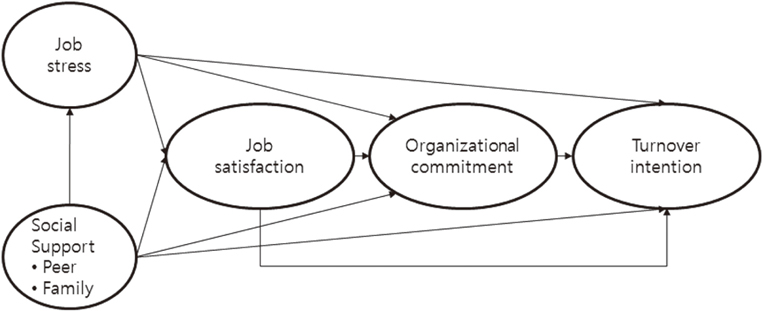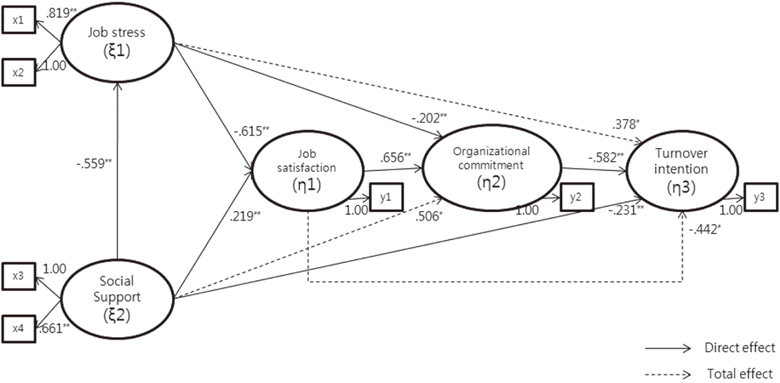J Korean Acad Nurs.
2012 Feb;42(1):9-18. 10.4040/jkan.2012.42.1.9.
A Model on Turnover Intention of Chief Nurse Officers
- Affiliations
-
- 1Department of Nursing, Sunchon National University, College of Life Science and Natural Resources, Sunchon, Korea.
- 2Department of Nursing, Dankook University, Cheonan, Korea. jongkimk@dankook.ac.kr
- 3College of Nursing, Eulji University, Daejeon, Korea.
- 4Seoul National University Hospital, Seoul, Korea.
- KMID: 1245153
- DOI: http://doi.org/10.4040/jkan.2012.42.1.9
Abstract
- PURPOSE
The purpose of this study was to test the turnover intention model for chief nurse officers in general hospitals. The variables for the study included job stress, social support, job satisfaction, and organization commitment.
METHODS
A predictive, non-experimental design was used with a sample of 144 chief nurse officers from 144 general hospitals. Data were collected using self-administered questionnaires and analyzed using SPSS, AMOS program.
RESULTS
The overall fitness of the hypothetical model to the data was good (chi2=16.80, p=.052, GFI=.96, AGFI=.90, NFI=.97, CFI=.99). Job stress, social support, job satisfaction, and organization commitment explained 59.0% of the variance in turnover intention by chief nurse officers. Both organization commitment and social support directly influenced turnover intention for chief nurse officers, and job stress and job satisfaction indirectly influenced turnover intention.
CONCLUSION
The results imply that chief nurse officers in hospitals need social support and management of job stress to increase job satisfaction and organization commitment, and lower turnover intention.
Keyword
MeSH Terms
Figure
Cited by 1 articles
-
Literature Review of Structural Equation Models for Hospital Nurses' Turnover Intention in Korea
Eunhye Kim, Jinhyun Kim
Perspect Nurs Sci. 2014;11(2):109-122. doi: 10.16952/pns.2014.11.2.109.
Reference
-
1. AbuAlrub R.F., Al-Zaru I.M. Job stress, recognition, job performance and intention to stay at work among Jordanian hospital nurses. Journal of Nursing Management. 2008. 16:227–236. http://dx.doi.org/10.1111/j.1365-2834.2007.00810.x.2. An S.Y., Kim H.S. The effect of family, job, and organization-related situation to turnover intention of women managers. The Women's Studies. 2009. 77(2):5–48.3. Bae B.L. Structural equation modeling with AMOS 17.0. 2009. Seoul: Cheongram.4. Bettencourt L.A., Brown S.W. Role stressors and customer-oriented boundary-spanning behaviors in service organizations. Journal of the Academy of Marketing Science. 2003. 31(4):394–408. http://dx.doi.org/10.1177/0092070303255636.5. Chang S.J., Koh S.B., Kang D., Kim S.A., Kang M.G, Lee C.G., et al. Developing an occupational stress scale for Korean employees. Korean Journal of Occupational and Environmental Medicine. 2005. 17(4):297–317.6. Ha N.S., Choi J. The relationship among leadership style of nurse managers, job satisfaction, organizational commitment, andturnover intention. Journal of Korean Academy of Nursing. 2002. 32:812–822.7. Ha N.S., Choi J. An analysis of nursing competency affecting on job satisfaction and nursing performance among clinical nurses. Journal of Korean Academy of Nursing Administration. 2010. 16:286–294.8. Hair J.F., Black W.C., Babin B.J., Anderson R.E., Tatham R.L. Multivariate data analysis. 2006. 6th ed. Upper Saddle River, NJ: Prentice Hall.9. Havens D.S., Thompson P.A., Jones C.B. Chief nursing officer turnover: Chief nursing officers and healthcare recruiters tell their stories. The Journal of Nursing Administration. 2008. 38:516–525. http://dx.doi.org/10.1097/NNA.0b013e31818ebf32.10. Jones C.B., Havens D.S., Thompson P.A. Chief nursing officer retention and turnover: A crisis brewing? Results of a national survey. Journal of Healthcare Management. 2008. 53:89–105.11. Kang S.Y., Park K.O., Kim J.K. The role adaptation process of the executive director of nursing department. Journal of Korean Academy of Nursing. 2010. 40:785–798.12. Kim C.H., Yang S.S., Kim Y.J., Son Y.J., You M.A., Song J.E. A structural model of nurses turnover intention. Journal of Korean Academy of Nursing Administration. 2009. 15:550–562.13. Kim M.H., Jung M.S. The effect of head nurses' emotional leadership on nurses' job satisfaction & organizational commitment. Journal of Korean Academy of Nursing Administration. 2010. 16:336–347.14. Kline R.B. Principle and practice of structural equation modeling. 2005. 2nd ed. New York, NY: Guilford Press.15. Kwon J.S., Sohn I.S., Cho S.H., Han Y.H., Park K.S. A survey about work conditions of hospital nurses. 2009. Seoul: Association of Hospital Nurses.16. Langford C.P., Bowsher J., Maloney J., Lillis P.P. Social support: A conceptual analysis. Journal of Advanced Nursing. 1997. 25(1):95–100. http://dx.doi.org/10.1046/j.1365-2648.1997.1997025095.x.17. Lawler E.E. Satisfaction and behavior. 1983. New York, NY: McGraw Hill.18. Lee B.S., Jung Y.S., Lee E.J., Jo E.J., Kang S.R., Ahn H.K., et al. Nursing management. 2008. Seoul: Jungdam.19. Lee H., Lim J. Structural equation modeling and AMOS 16.0. 2009. Seoul: Bupmoonsa.20. Marquis B.L., Houston C.J. Leadership roles and management functions in nursing: Theory and application. 2005. 5th ed. Philadelphia, PA: Lippincott Williams & Wilkins.21. Mobley W.H. Intermediate linkages in the relationship between job satisfaction and employee turnover. Journal of Applied Psychology. 1977. 62(2):237–240. http://dx.doi.org/10.1037/0021-9010.62.2.237.22. Mowday R.T., Steers R.M., Porter L.W. The measurement of organizational commitment. Journal of Vocational Behavior. 1979. 14(2):224–247. http://dx.doi.org/10.1016/0001-8791(79)90072-1.23. Park H.S. Relationship between perceived nursing care role orientation, job characteristics, and turnover among nurses. 2002. Seoul: Yonsei University;Unpublished master thesis.24. Park J.W. A study for development of social support. 1985. Seoul: Yonsei University;Unpublished doctoral dissertation.25. Price J.L., Mueller C.W. Absenteeism and turnover of hospital employees. 1986. Stanford, CA: JAI Press.26. Sager J.K. A structural model depicting salespeople's job stress. Journal of the Academy of Marketing Science. 1994. 22(1):74–84. http://dx.doi.org/10.1177/0092070394221007.27. Shin Y.G. Human resource management. 2001. Seoul: Sinkwang publishing Co.28. Yoon G.S., Kim S.Y. Influence of job stress and burnout on turnover intention of nurses. Journal of Korean Academy of Nursing Administration. 2010. 16:507–516.29. Yoon J.A., Lee H.J. Internal marketing, job stress, organizational commitment and turnover intention in nursing organization. Journal of Korean Academy of Nursing Administration. 2007. 13:293–301.30. Weiss D.J., Dawis R.V., England G.W., Lofguist L.H. Manual for the Minnesota Satisfaction Questionaire. 1967. Minneapolis, MN: University of Minnesota, Industrial relations Center.
- Full Text Links
- Actions
-
Cited
- CITED
-
- Close
- Share
- Similar articles
-
- An influence of emotional labor, emotional intelligence, and social support of emergency room nurse on turnover intention
- A Prediction Model on the Male Nurses' Turnover Intention
- A Structural Model of Hospital Nurses' Turnover Intention: Focusing on Organizational Characteristics, Job Satisfaction, and Job Embeddedness
- Impact of Unit-level Nurse Practice Environment on Nurse Turnover Intention in the Small and Medium Sized Hospitals
- Factors Influencing Turnover Intention in Clinical Nurses: Compassion Fatigue, Coping, Social Support, and Job Satisfaction



